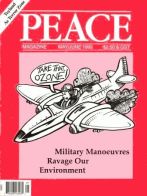
Peace Magazine May-Jun 1992, page 30. Some rights reserved.
Search for other articles by PMag staff here
By Subha Xavier
NEW YORK CITY-On February 29, 1992, more than 1500 people filled a high school auditorium in New York to witness the International War Crimes Tribunal. It charged U.S. President George Bush and his entourage with 19 separate crimes against humanity. The crimes were for the most part direct violations of international law, either under the Charter of the United Nations or the 1949 Geneva convention. The tribunal was the final hearing of a series of public inquiries held in over twenty different countries, all initiated and presided over by former U.S. Attorney General Ramsey Clark.
Twelve eminent judges of different national backgrounds, but with similar histories of humanitarian struggles, listened to the testimony. The tribunal was divided into three sections, each with its respective prosecutor and witnesses. The 19 accounts with which the U.S. government was charged were said to be crimes committed before, during, and after the Gulf Wan The first of the three sections was presided over by Ramsey Clark himself. It dealt with the destruction of Iraqi infrastructure, of the environment, and with civilian damage and attacks on retreating military.
Clark delivered a passionate and realistic opening speech that won hearts and minds easily. Clark had visited Iraq during and after the Gulf War and his speech in itself was an eyewitness testimony.
Other witnesses included Mohammed Khader, an Iraqi victim before whose eyes a bomb shelter where his wife and daughters had sought refuge was blown to pieces by an allied jet. Inside that very shelter more than three hundred other women and children had also sought protection. Testimonies were also heard from GIs who had resisted the war and those who had not an estimated 8000 soldiers were said to have deserted the war and another 2000 were said to have been conscientious objectors who as a consequence faced physical and verbal abuse, and financial penalties as the cost of their rebellious actions. Hundreds are languishing in jail today.
Sahu Barron, the prosecutor for the second section of the tribunal, spoke on the charges accusing the U.S. government of planning and preparing for the Gulf War two years ahead. "The War Crimes perpetrated," she said, "were accompanied by premeditated criminal in-tent." Bill Doanes, one of the witnesses in this section, who had done much research on this subject, spoke of a "plan 1002" conceived by the U.S. government in 1988 which planned an invasion of Iraq. Following the creation of this plan, General Schwarzkopf paid many visits to Kuwait, supposedly encouraging Kuwait to provoke Iraq into an invasion. In 1990, when Iraq did invade Kuwait this plan was put into effect, only this time under the new code 1002-90. The audience was stunned by the evidence.
The corruption of the United Nations, the usurping of constitutional power, and media manipulation were other topics of this second section. Under media manipulation, one of the facts brought up was that among the 93 members of the press present, not one was American.
The final part of the tribunal was presided by Joan Sekler. Emphasis was on the Kurdish tragedy; the displacement of the Yemenis, Africans, Palestinians, South Asians and others; and the attacks on Palestinians and guest workers in Kuwait. Dr. Detlef Engebastien, a German physician who worked in Iraq during the war, spoke of the 5000 to 6000 children dying each month because of continuing sanctions. Video footage of "The Highway of Death" showed horrible images that brought tears to the eyes of viewers.
The tribunal was to last four hours, instead it lasted six. But time was hardly a factor to the audience. The final verdict was guilty, and was greeted with applause and shouts of "Guilty! Guilty!" Ramsey Clark reappeared to give a resounding closing speech, described his vision for a new world order, of peace and justice for all nations and peoples. The auditorium resounded once again with applause.
The results of the tribunal were presented to the United Nations on March 1, 1992 along with the findings of the Commission.
The one flaw of the tribunal was that it did not consider the crimes of Saddam Hussein. The tribunal received virtually no attention in the mainstream press.
Subha Xavier is a student in Montreal.
TORONTO-A controversy arose in April over a characterization by the York University student newspaper, Excalibur, of a nominee for the presidency of the university. Stephen Fienberg had been a Dean of Arts at an American university that was deeply involved in Star Wars research. His move to York as Vice-President was taken to mean that the university intended to become involved in military research. However, the current President, Harry Arthurs, assured PEACE that this is not so. He says York has indeed bid to become home to the International Space University, but that organization has no military functions.
Knowing that most Canadians want a decrease in the military budget, the government tried to make it look as if they gave us one. Two outraged citizens explain how the illusion is created, and why.

Peace Magazine May-Jun 1992, page 30. Some rights reserved.
Search for other articles by PMag staff here